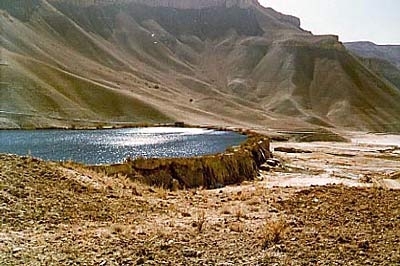Afghan Mountains semi-desert
The Afghan Mountains semi-desert is an ecoregion in Afghanistan encompassing a disjunct area of approximately 5300 square miles. This ecoregion is classified within the Deserts and Xeric Shrublands biome. The Afghan mountains semi-desert consist of three discrete interior valleys of the northern Hindu Kush Mountain Range.
A low canopy thorny scrub dominates the vegetation palette of the ecoregion, the canopy height scarcely exceeding 150 centimeters. Overgrazing by domesticated livestock, especially cattle and goats, threaten the integrity of the flora here. There is no vertebrate endemism in the Afghan Mountains semi-desert, although there are eight threatened mammal species and a single Vulnerable bird species that occurs here.
Contents
Location and general description
The ecoregion is a rather arid geographic unit, in which annual precipitation is approximately 250 to 300 millimeters. The open canopy thorny scrub presents a vegetative cover of about ten percent, with admixtures of graminoids in many areas. The geometry of the Afghan Mountains semi-desert actually consists of three disjunct areas within the nation of Afghanistan; these valleys are generally situated in the northern central part of Afghanistan.
Biodiversity features
There are only 95 native vertebrate species found in this ecoregion, with vertebrate endemism being nil. Special status mammals in the Afghan Mountains semi-desert are the Near Threatened argali (Ovis ammon), the Vulnerable Asiatic black bear (Ursus thibetanus), the Near Threatened Euphrates jerboa (Allactaga euphratica), the Near Threatened leopard (Panthera pardus), the Near Threatened Schreiber's long-fingered bat (Miniopterus schreibersii), the Endangered snow leopard (Uncia uncia), the Near Threatened striped hyena (Hyaena hyaena) and the Endangered white-bellied musk deer (Moschus leucogaster). There is a single Vulnerable avian species found here: the Vulnerable beautiful nuthatch (Sitta formosa).
The lower lying semi-desert of the west of the ecoregion are dominated by sparse open occurrences of the genera Zygophyllum, Brahuica, Amygdalus; most of these representatives are dwarf scrub thorny species, whose height generally ranges from 0.5 to 1.5 meters Other genera of widespread occurrence in the ecoregion are Atriplex, Acanthophyllum and Cousinia. Overall major vegetative occurrences are along the dry river beds of the ecoregtion
Graminoids are under pressure from overgrazing, even though such livestock are managed in a nomadic fashion. Members of the Poa, Agropynum, Stipa, Festuca and Carex are widespread. Some specific graminoids in abundance are Poa bulbosa and Carex pachystylis. Such overgrazing promotes propagtion of genus Artemesia members at the expense of the graminoids.
Other plant species present include Convolvulus spinosus and taxa from the Ferula, Agropyon, Anemome, and Gagea species. In some areas of the Bamiyan Province, there is considerable dominance by genus Salsola taxa.
Prehistory
This region represents one of the western elements of the Northern Silk Road, allowing trade routes to open between the East and West as early as the first millennium BC. The Northern Silk Road brought this region into recorded history with manufactured goods from the Greek and Roman Empires moving eastward, and various silk goods and minerals moving westward from China.
Current status
The conservation status of the Afghan Mountains semi-desert is classified as Critical/Endangered; however the
this ecoregion is not classified as a G200 region, meaning it is not regarded as of the highest priority worldwide for conservation.
Types and severity of threats
Overgrazing by domesticated livestock, especially cattle and goats, threaten the integrity of the flora here. Over the last four decades beginning with the Soviet invasion, there have been continuous tribal warfare and terrorist training camps which have inflicted scars on the landscape. The last decade has restored some measure of political stability, giving measured optimism for a better future.
Justification of ecoregion delineation
This ecoregion consists of small interior valleys in the northern slope of the Afghan mountains. Semi-desert communities dominated by Amygdatus from Freitag’s (1971) natural vegetation map were used for the ecoregion boundaries. The Afghan Mountains semi-desert is designated by the nomenclature PA1301 according to the World Wildlife Fund ecoregion delineation.
See also
References
- Freitag, H. 1971. Studies in the Natural Vegetation of Afghanistan. Pages 89-106 in P.H. Davis, Harper, and I.C. Hedge, editors. Plant Life of Southwest Asia. The Botanical Society of Edinburgh, Edinburgh.
- J.M.Adams. 2007. Vegetation-climate interaction how vegetation makes the global environment. Berlin: Springer.
- Francis Rawdon Chesney. 1850. The expedition for the survey of the rivers Euphrates and Tigris. 798 pages books.google.com
- CRU TS 3.1 - University of East Anglia Climate Research Unit (CRU). Jones, Ian Harris. CRU Time Series (TS) high resolution gridded datasets, [Internet]. NCAS British Atmospheric Data Centre, 2008, Accessed: 28-July-2011
- C.Michael Hogan. 2007. Silk Road, North China. ed.A.Burnham. Megalithic Portal
- Lawrence Krader. 1955. Ecology of Central Asian Pastoralism, Southwestern Journal of Anthropology, Vol. 11, No. 4
- United Nations Environment Programme. 2008. Biodiversity profile of Afghanistan. Kabul, Afghanistan
- World Wildlife Fund. 2002. Afghan Mountains semi-desert

